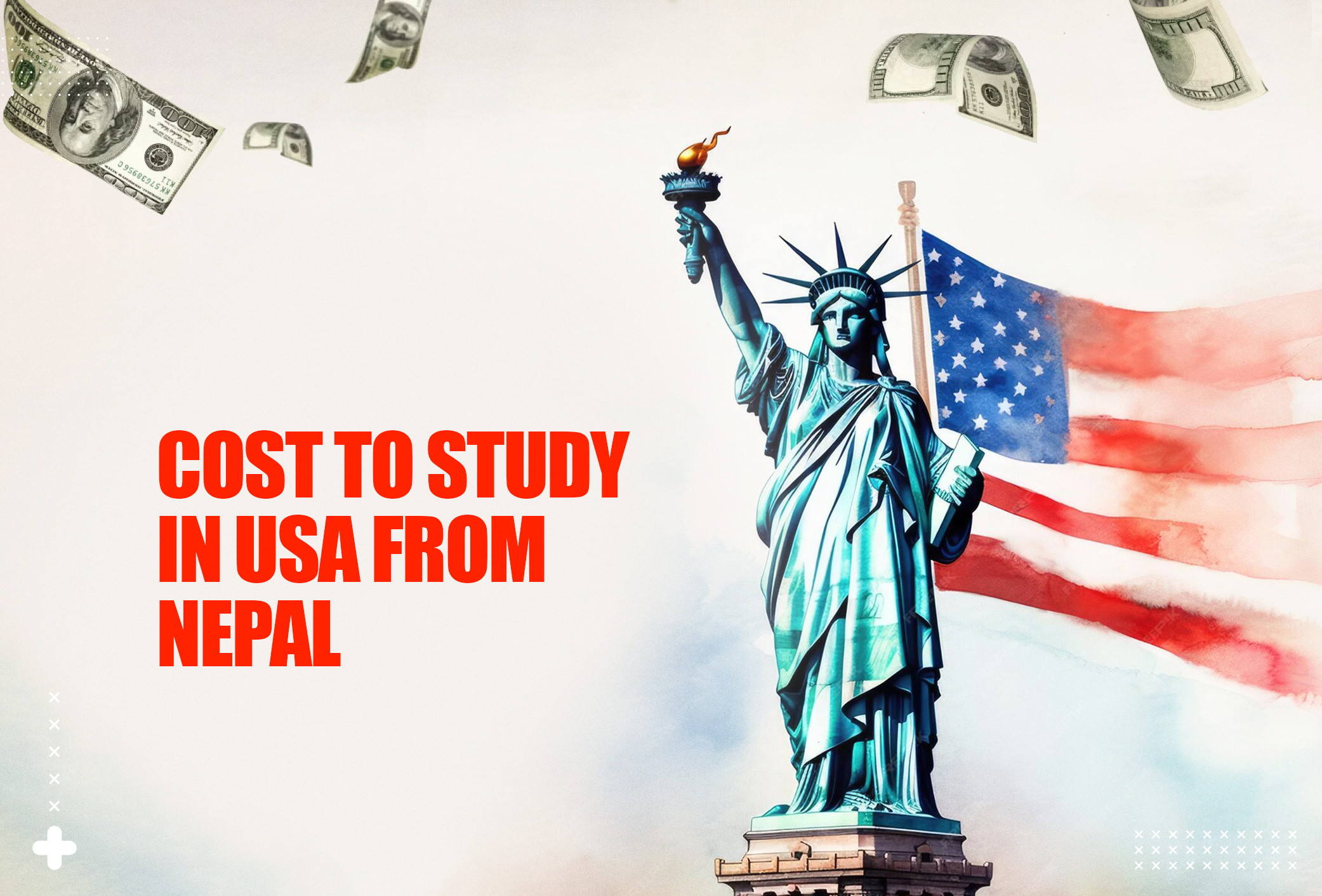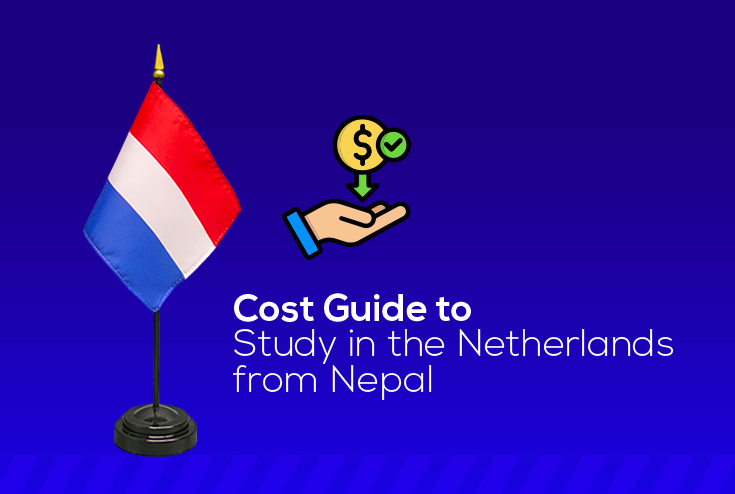
Cost to study in USA from Nepal | A Comprehensive Guide 2025
The dream of studying in the USA has long attracted Nepali students eager to explore world-class education and opportunities. However, understanding the cost to study in USA from Nepal is a critical first step in planning your journey. From tuition fees and living expenses to hidden costs like health insurance and visa fees, every detail matters when preparing your budget.
This guide dives deep into the financial aspects Nepali students need to consider, offering clear insights into what it takes to manage your expenses effectively while studying in the USA.
Table of Contents
- Cost to study in USA
- Tuition Fees
- Cost Comparison: Public vs. Private Institutions
- Living Expenses in USA for Nepali Students
- Other Personal Expenses
- Student Visa and Application Fees
- Travel and Flight Expenses for USA from Nepal
- Scholarships and Financial Aid in USA for International Students
- Work While Studying in USA
- Tips for Budgeting and Saving Costs in USA
- Smart Budgeting Tips for International Students in USA
- Conclusion
Cost to study in USA from Nepal
This section of the blog breaks down all the necessary costs you need to think about while studying in the USA as an international student.
Tuition Fees
These are the amounts you must set apart for your education. Below is the estimated cost range of tuition fees for different programs in the USA.
Undergraduate Programs
On average, tuition fees for undergraduate courses in the USA range from $20,000 to $40,000 annually. However, these costs can vary widely depending on whether you choose a public or private institution, with private colleges typically being more expensive.
Graduate Programs
Graduate studies in the USA often have higher tuition fees, with costs ranging from $20,000 to $45,000 or more per year. Again, the choice between public and private institutions significantly affects the overall cost.
Cost Comparison: Public vs. Private Institutions
The tuition fees of public and private institutions in the USA vary largely. The cost planning for either of the options can look significantly different. Here’s how:
| Factors | Public Universities | Private Universities |
|---|---|---|
| Tuition Costs | $8,000–$18,000 annually for international students. | $17,000–$35,000+ annually. |
| Scholarships and Financial Aid | Limited scholarships; international students may need to rely more on personal funds. | More generous merit and need-based scholarships and financial aid options. |
| Cost Predictability | More predictable and consistent tuition rates year-to-year. | Tuition may increase annually, compelling students to spend higher costs. |
| Living Costs | Often located in suburban or smaller cities, leading to lower housing and living expenses. | Frequently in urban areas where living costs are higher. |
| Additional Costs | Often have lower fees for services like labs, libraries, and campus facilities. | Additional fees for private facilities and extracurricular resources can add to costs. |
| Overall Affordability | Better for students on a tighter budget with limited external funding. | May be affordable if you secure scholarships or aid. |
Living Expenses in USA for Nepali Students
Your living expenses can include your food, shelter, transportation, and other essentials. The following are the probable costs you may need to budget for living in the USA as an international student:
Accommodation Costs
Where you live will have a big impact on your overall expenses. Here are your main options:
| On-Campus Dormitories | Universities in the USA often provide on-campus housing, which can be more convenient and cost-effective as utilities like electricity and Wi-Fi are included. Expect to spend around $8,000 to $12,000 per year for your on-campus living options, depending on the location and university. |
| Off-Campus Apartments | Renting off-campus gives you more freedom but can be pricier. Monthly rent varies by city. In smaller towns in the USA, the rents may vary from $500 to $800, while the rent in bigger cities like New York or Los Angeles can vary from $1,200 to $2,500. |
Keep in mind that off-campus housing comes with extra costs like furniture and utilities, so you have to plan accordingly.
The other costs can involve:
Food and Groceries
Your food budget depends on your lifestyle and whether you cook or eat out:
| Cooking at Home | Groceries can cost around $200 to $400 per month. Shopping smart at stores like Walmart, Costco, or ethnic groceries can save you money. |
| Dining Out | Eating out is more expensive, with casual meals costing $10 to $20 each. While it’s okay to treat yourself occasionally, cooking at home is much more budget-friendly. |
Transportation Costs in USA
Travelling around will also add to your monthly expenses, depending on where you live and how you commute:
| Public Transportation | Cities like Chicago and New York have reliable public transit systems, with monthly passes costing $60 to $150. |
|---|---|
| Owning a car | If you plan to drive, you need to consider fuel, insurance, and maintenance, which can add up to around $1025 per month. |
Tip: Opting for public transport is usually cheaper, especially in cities with well-connected systems.
Other Personal Expenses
Here’s what you’ll likely spend on day-to-day needs:
| Laundry | Around $10 to $30 per month, depending on your access to washing facilities. |
|---|---|
| Books and Stationery | Your extra education needs like stationeries may cost you around $500- $1000. |
| Personal Care Items | Budget about $20 to $50 per month for toiletries and other essentials. |
| Entertainment | You may want to budget around $10 to $100 per month for streaming services or occasional outings. |
| Health Insurance | Mandatory for international students, health insurance costs range from $500 to $1,000 annually. |
Student Visa and Application Fees
The visa application process involves a fee of $160 for the application and $350 for the SEVIS fee, which is essential for maintaining your student status in the US.
Travel and Flight Expenses for USA from Nepal
Travel expenses include initial airfare, which can range from $1,000 to $1,500, and additional costs for travel within the US or back home during breaks.
Scholarships and Financial Aid in USA for International Students
Many US institutions offer scholarships and financial aid for international students, including those from Nepal. These can significantly reduce the financial burden of tuition and living expenses.
You Might Be Interested in: Scholarships in USA for Nepali Students
Work While Studying in USA
The US permits both on-campus and off-campus employment for international students, providing a way to earn money and gain work experience while studying. However, each provision comes with its set of rules and eligibility criteria. Let’s understand what these mean and how you can work while studying in USA as a Nepali student:
On-Campus Employment
On-campus employment in the USA refers to jobs located within the university premises, such as positions at the library, dining halls, or student centres, and is generally available to both domestic and international students.
Work Hours: Up to 20 hours per week during semesters and 40 hours per week during breaks.
Off-Campus Employment
Off-campus employment involves jobs outside the university, like internships or part-time roles at local businesses, and usually requires specific work authorization for international students. There are three main types of off-campus employment for F-1 students:
- Curricular Practical Training (CPT)
For internships or jobs directly related to your studies. Requires school authorization. - Optional Practical Training (OPT)
OPT allows you to work in your field of study for up to 12 months during or after completing your degree. STEM students may qualify for an additional 24-month extension.
Working while studying helps with expenses and builds valuable experience, but be sure to follow the rules to maintain your visa status. Also, keep focus on balancing both your work and studies.
Tips for Budgeting and Saving Costs in USA
Managing your finances wisely is a key part of living in the USA as a Nepali student. Effective planning includes keeping track of exchange rates, budgeting for monthly expenses, and saving whenever possible. Adopting small habits, like taking advantage of student discounts and living frugally, can make a big difference in your overall financial well-being.
The Impact of Exchange Rates
The fluctuating exchange rate between the Nepalese Rupee (NPR) and the US Dollar (USD) can have a significant impact on your expenses. Since even small changes can affect your monthly costs, it’s important to:
- Monitor exchange rates regularly.
- Transfer money during favourable rates, if possible.
Preparing Financially for Your Studies
Starting early with financial planning ensures a smoother transition to studying in the USA. Here are some essential steps:
- Sufficient Funds
Make sure you meet the visa requirement for proof of funds, which typically includes covering your first year’s tuition and living expenses. - Emergency Savings
Have a financial backup for unexpected costs like medical emergencies, extra study materials, or travel. - Research Costs
Understand the specific costs at your university, including tuition fees, accommodation, and other charges, so you can budget accurately.
Smart Budgeting Tips for International Students in USA
Set a Budget
Keep track of all your expenses - rent, food, transportation, and entertainment. Regularly reviewing your budget can help you avoid overspending.
Look for Discounts
Many places in the USA offer student discounts on transportation, food, entertainment, and even clothing. Always ask for available discounts before making purchases.
Consider Part-Time Jobs
On-campus part-time jobs allowed under F-1 visa rules can help offset your expenses and provide valuable work experience.
Share Housing
Renting an apartment with roommates can significantly lower your costs for rent and utilities. It’s also a great way to build connections.
Cook at Home
Preparing your meals instead of dining out regularly can save you hundreds of dollars each month. Shopping at budget-friendly stores like Walmart or local ethnic groceries is another cost-effective option.
By planning your finances carefully and making conscious spending decisions, you can focus on your studies without unnecessary financial stress.
Conclusion
Studying in the USA from Nepal is an ambitious goal that requires careful financial planning and an understanding of the costs involved. By exploring scholarships, working part-time, and budgeting wisely, you can make your dream of studying in the USA a reality.
FAQ - Cost to Study in USA from Nepal
How much does it cost to study in the USA from Nepal?
The cost to study in the USA from Nepal varies depending on the university, program, and location. On average, tuition fees range from $20,000 to $45,000 annually. Living expenses, including accommodation, food, and transportation, can add $10,000 to $15,000 per year.
Are there scholarships available for Nepali students in the USA?
Yes, many US universities offer scholarships for Nepali students. These include merit-based, need-based, and program-specific scholarships that can significantly reduce tuition and living costs.
What is the total cost to apply USA from Nepal?
The US student visa (F-1) application fee is $160, and the SEVIS fee is $350, totaling $510. The initial flight from Nepal to the USA typically costs $1,000–$1,500. Additional travel expenses within the USA or during holidays will vary.
Can I study in the USA with 20 lakhs?
Studying in the USA with 20 lakhs is challenging but possible. Opting for affordable universities, applying for scholarships, and working part-time can help reduce the financial burden. Additionally, community colleges may offer lower tuition fees.
Is it expensive to study in the USA?
Yes, studying in the USA can be expensive. However, scholarships, part-time jobs, and careful budgeting can help manage the costs.
Also Read
Best Consultancy in Nepal for USA: A Detailed Guide for 2025
Study in USA from Nepal: A detailed Guide 2024
Top Courses in USA : A Comprenshive Guide 2024





Get Guidance